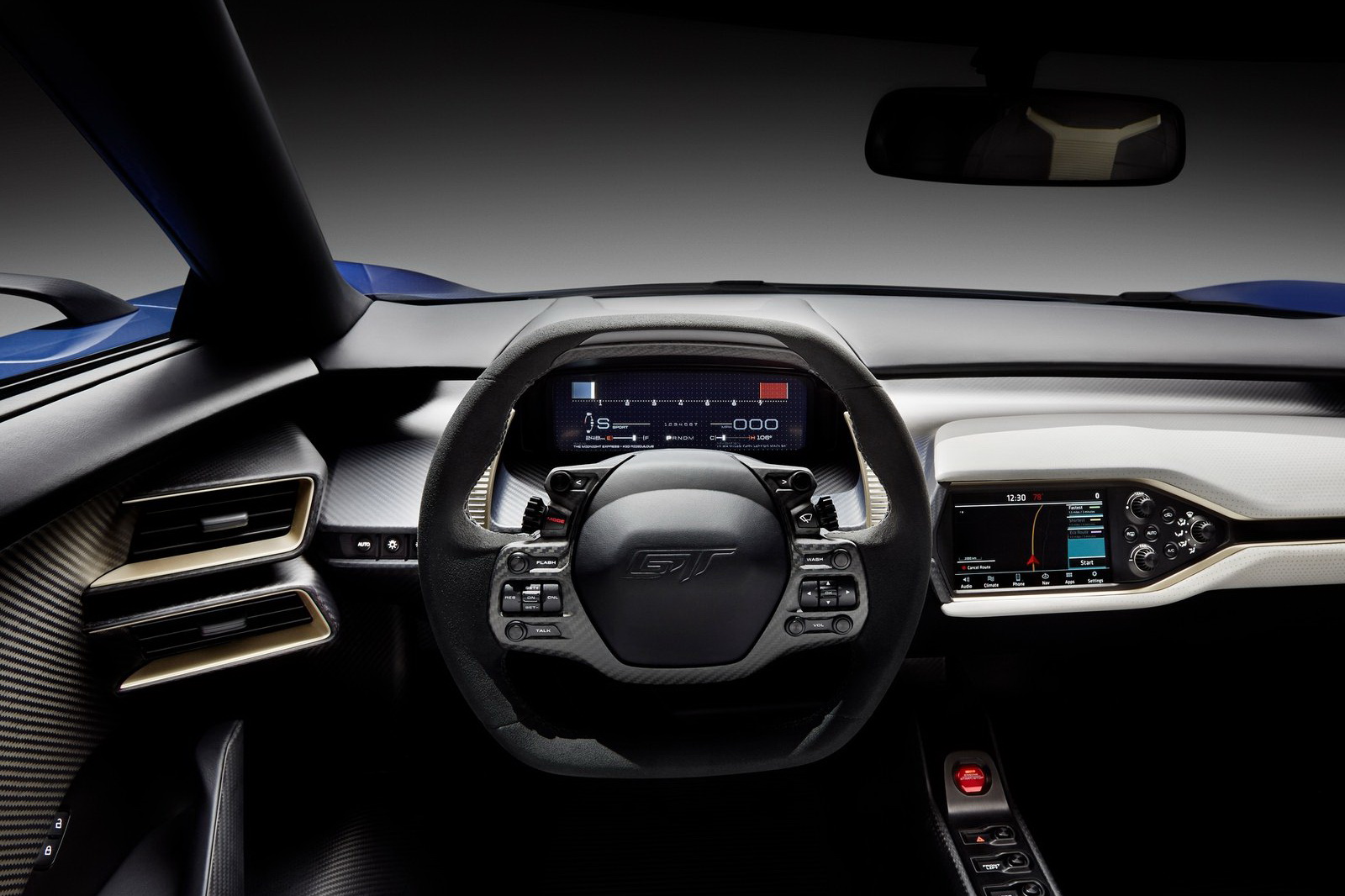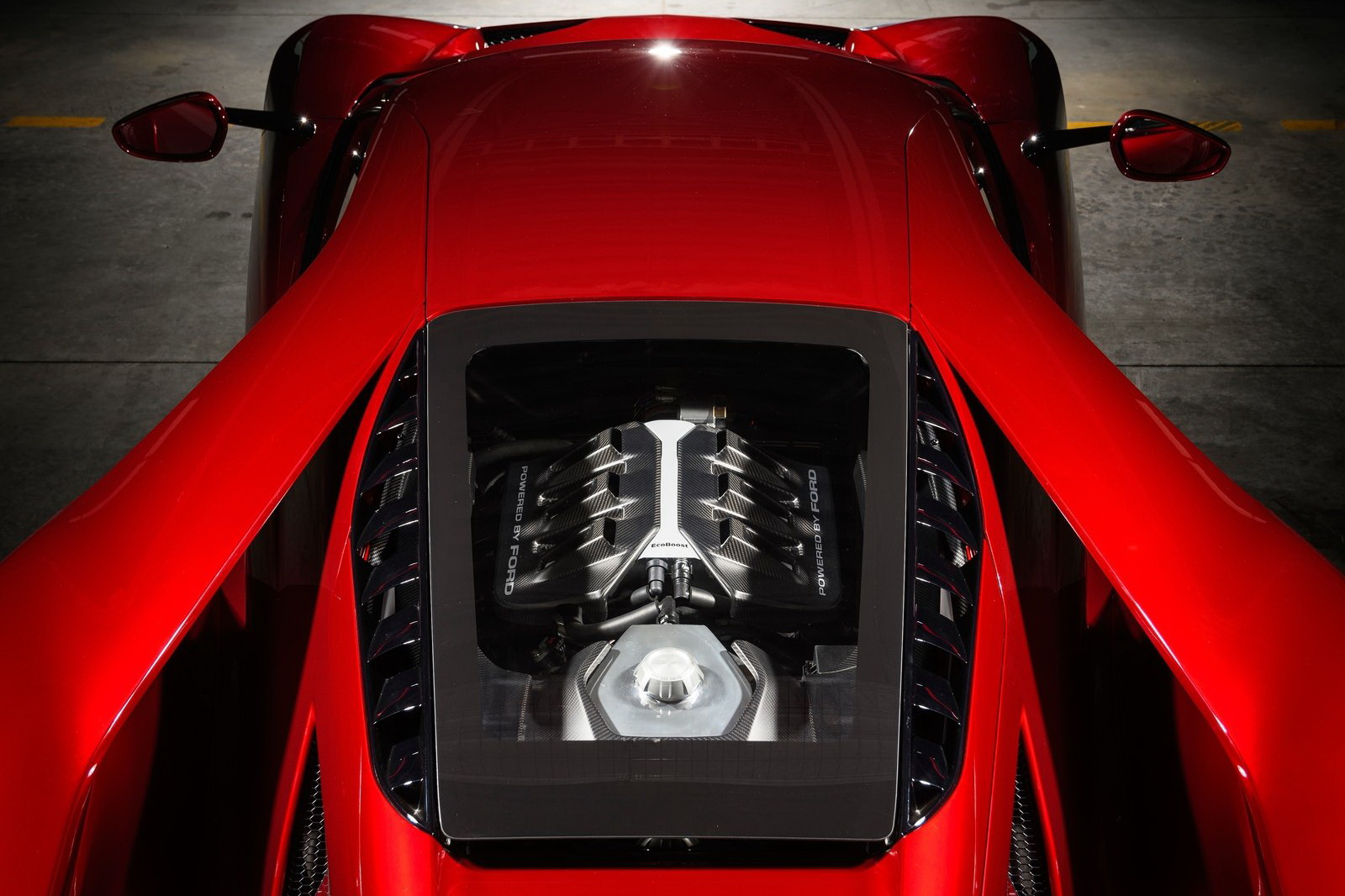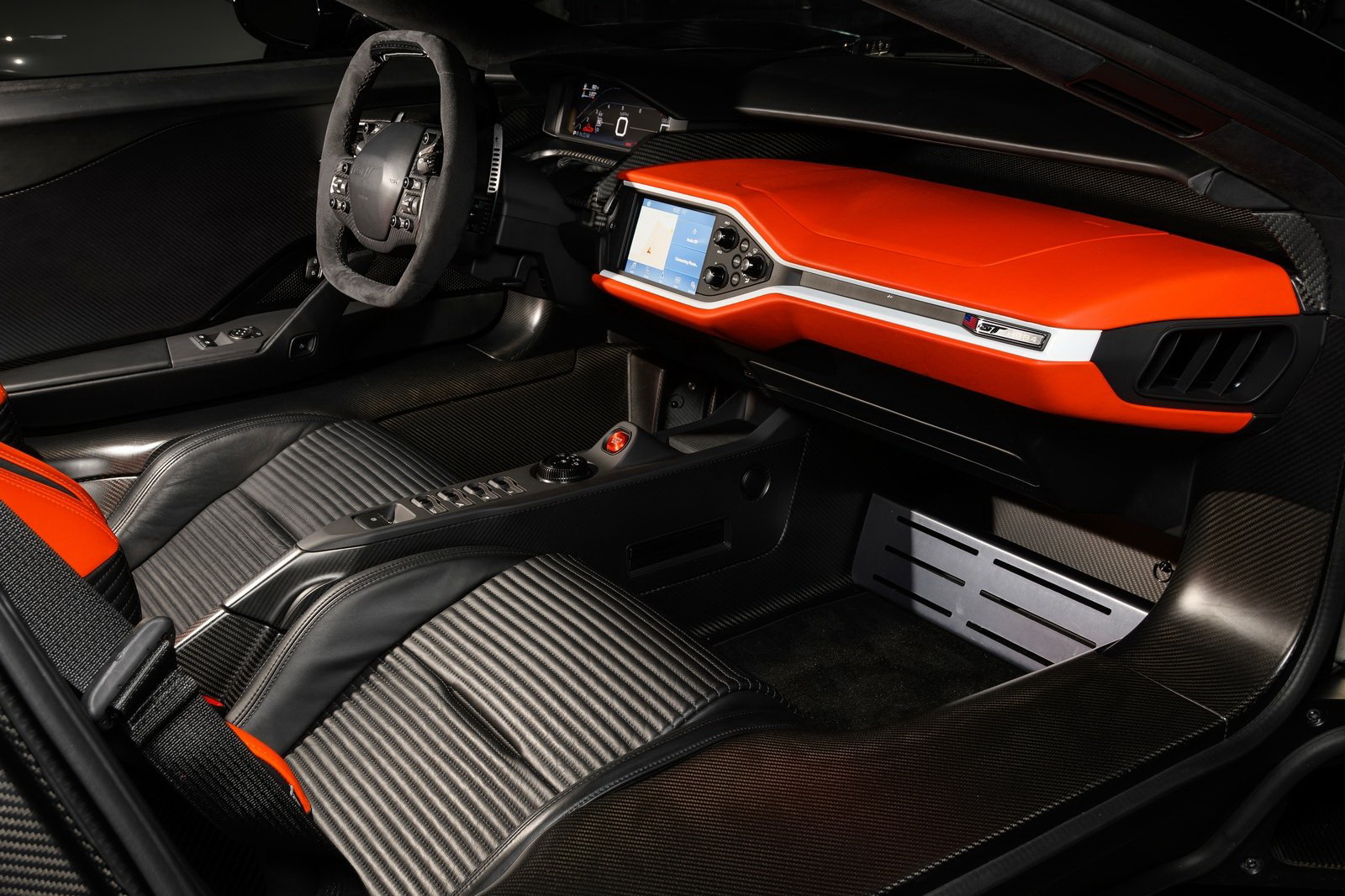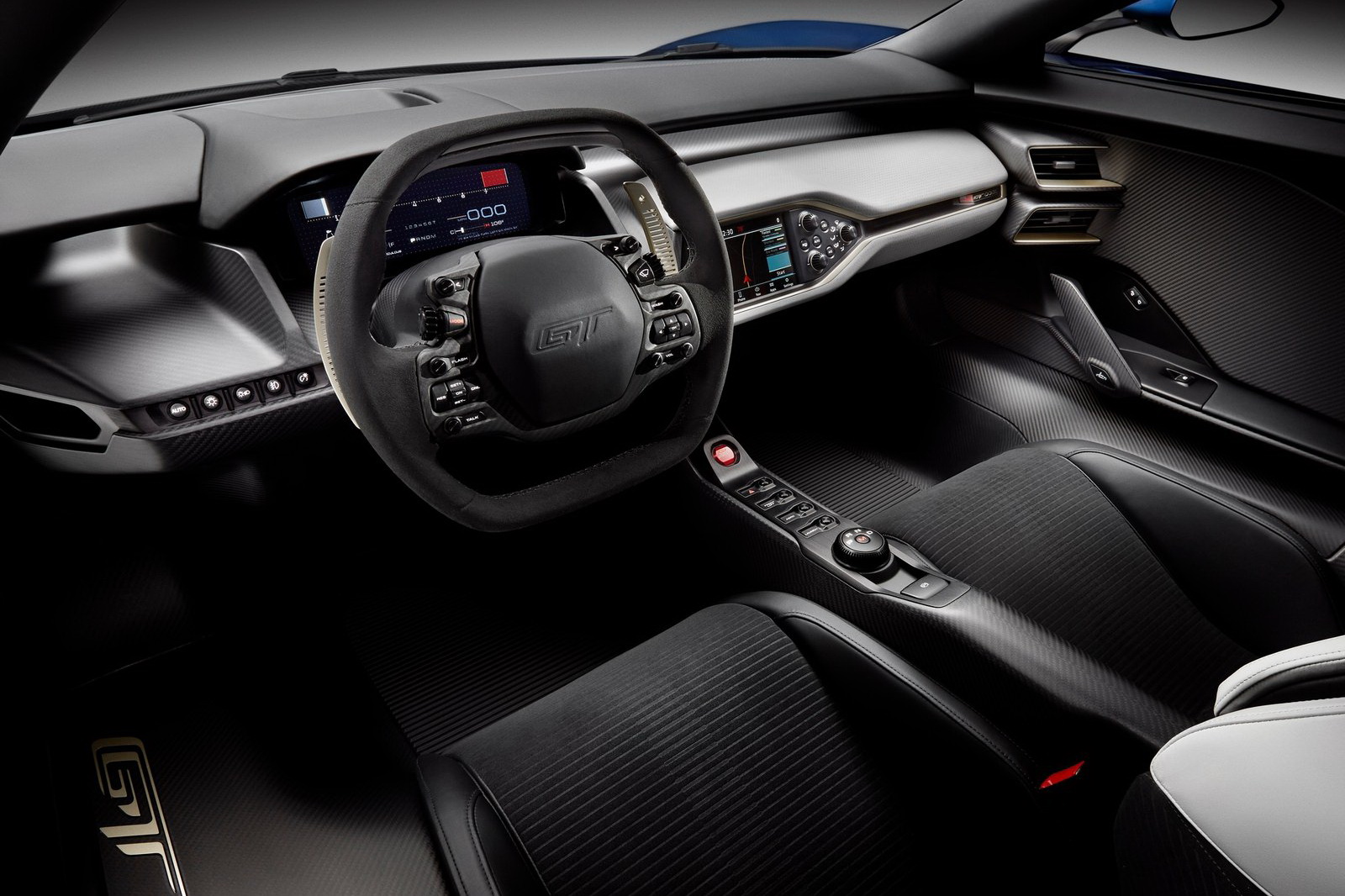

Carbon fiber innovation
Few innovations provide a more wide-ranging performance and efficiency advantage than reducing weight. All factors of a vehicle’s capabilities – acceleration, handling, braking, safety, efficiency – can improve through the use of advanced, lighter materials.
The all-new Ford GT features advanced lightweight composites, which will help serve Ford’s entire product lineup moving forward. With the broad application of structural carbon fiber elements, the GT will exhibit one of the best power-to-weight ratios of any production car.
Anchored by a carbon fiber passenger cell, the GT features aluminum front and rear subframes encapsulated in structural carbon fiber body panels. Carbon fiber is one of the world’s strongest materials for its mass – enabling an ultra-stiff foundation for chassis components, while creating a lighter overall package for increased dynamic performance and efficiency.

Most powerful production EcoBoost ever
Ford EcoBoost technology is available in every new Ford car, utility and light-duty pickup in North America beginning this year.
EcoBoost engines power a growing number of Ford performance models, including the new Mustang, just-announced F-150 Raptor, as well as Fiesta ST and Focus ST.
Based on the same race-proven engine architecture serving Ford’s IMSA Daytona Prototype endurance racing efforts, the next-generation twin-turbocharged 3.5-liter EcoBoost V6 in the GT features a wide powerband with impressive time-to-torque characteristics.
The engine demonstrates remarkable efficiency – a key attribute of its endurance racing-derived powertrain, where exceptional performance combined with efficiency is a critical competitive advantage.
Ford’s twin-turbo EcoBoost V6 raced to three wins in its first season of the IMSA TUDOR United SportsCar Championship in 2014, including a win in the prestigious 12 Hours of Sebring, along with seven podiums over more than 15,000 endurance racing miles.
The Ford GT features an all-new, port/direct dual fuel-injection setup to improve engine response, plus a low-friction roller-finger-follower valvetrain. The twin-turbocharged EcoBoost V6 will be paired with a seven-speed dual-clutch transaxle for near-instantaneous gear changes and exceptional driver control.
Aero innovation gets active
Aerodynamic efficiency is at the heart of the GT design, actively reducing drag while aiding downforce and stability.
From its optimum tear-drop shape to its aircraft-inspired fuselage and visibility-enhancing curved windshield, every slope and shape is designed to minimize drag and optimize downforce.
Although each surface on the GT is functionally crafted to manage airflow, it also features fully active aerodynamic components to improve braking, handling and stability.
An active rear spoiler is keyed to both speed and driver input, reactively deploying and adjusting its height and/or pitch angle depending on conditions.

Designed for purpose
While it shares a legacy with classic Ford racing and performance cars, GT is a fully contemporary and functional shape that communicates modernity and pure beauty.
The state-of-the-art chassis is suspended by an active racing-style torsion bar and pushrod suspension, with adjustable ride height. The 20-inch wheels are shod with Michelin Pilot Super Sport Cup 2 tires featuring a unique compound and structure designed specifically for the Ford GT. Multi-spoke wheels encircle carbon-ceramic brake discs at all four corners.
The narrow-profile canopy reduces frontal area and caps a purposeful interior that provides state-of-the-art technology to ensure control, comfort and safety. The two-seat cockpit is accessed by upward-swinging doors, and features driver and passenger seats integrated directly into the carbon fiber passenger cell.
This configuration significantly reduces seating hardware and weight, and provides a consistent and direct sensory connection to the chassis. The fixed seating is combined with adjustable pedals and steering column to accommodate a very wide range of driver statures.
An F1-style steering wheel integrates all necessary driver controls, creating a stalkless steering column that allows uncluttered access to the transmission paddle-shift controls. A fully digital and configurable instrument cluster provides a wealth of driver-focused data. The display is configurable for multiple driving environments and different driving modes.
“While we hope enthusiasts rejoice about this all-new GT, all Ford customers will benefit from the ultimate performance Ford and its new-generation innovations,” said Nair.



















Carbon fiber innovation
Few innovations provide a more wide-ranging performance and efficiency advantage than reducing weight. All factors of a vehicle's capabilities - acceleration, handling, braking, safety, efficiency - can improve through the use of advanced, lighter materials.
The all-new Ford GT features advanced lightweight composites, which will help serve Ford's entire product lineup moving forward. With the broad application of structural carbon fiber elements, the GT will exhibit one of the best power-to-weight ratios of any production car. Anchored by a carbon fiber passenger cell, the GT features aluminum front and rear subframes encapsulated in structural carbon fiber body panels. Carbon fiber is one of the world's strongest materials for its mass - enabling an ultra-stiff foundation for chassis components, while creating a lighter overall package for increased dynamic performance and efficiency.

Most powerful production EcoBoost ever
Ford EcoBoost technology is available in every new Ford car, utility and light-duty pickup in North America beginning this year. EcoBoost engines power a growing number of Ford performance models, including the new Mustang, just-announced F-150 Raptor, as well as Fiesta ST and Focus ST. Based on the same race-proven engine architecture serving Ford's IMSA Daytona Prototype endurance racing efforts, the next-generation twin-turbocharged 3.5-liter EcoBoost V6 in the GT features a wide powerband with impressive time-to-torque characteristics.
The engine demonstrates remarkable efficiency - a key attribute of its endurance racing-derived powertrain, where exceptional performance combined with efficiency is a critical competitive advantage. Ford's twin-turbo EcoBoost V6 raced to three wins in its first season of the IMSA TUDOR United SportsCar Championship in 2014, including a win in the prestigious 12 Hours of Sebring, along with seven podiums over more than 15,000 endurance racing miles. The Ford GT features an all-new, port/direct dual fuel-injection setup to improve engine response, plus a low-friction roller-finger-follower valvetrain. The twin-turbocharged EcoBoost V6 will be paired with a seven-speed dual-clutch transaxle for near-instantaneous gear changes and exceptional driver control.
Aero innovation gets active
Aerodynamic efficiency is at the heart of the GT design, actively reducing drag while aiding downforce and stability. From its optimum tear-drop shape to its aircraft-inspired fuselage and visibility-enhancing curved windshield, every slope and shape is designed to minimize drag and optimize downforce.
Although each surface on the GT is functionally crafted to manage airflow, it also features fully active aerodynamic components to improve braking, handling and stability. An active rear spoiler is keyed to both speed and driver input, reactively deploying and adjusting its height and/or pitch angle depending on conditions.

Designed for purpose
While it shares a legacy with classic Ford racing and performance cars, GT is a fully contemporary and functional shape that communicates modernity and pure beauty. The state-of-the-art chassis is suspended by an active racing-style torsion bar and pushrod suspension, with adjustable ride height. The 20-inch wheels are shod with Michelin Pilot Super Sport Cup 2 tires featuring a unique compound and structure designed specifically for the Ford GT. Multi-spoke wheels encircle carbon-ceramic brake discs at all four corners. The narrow-profile canopy reduces frontal area and caps a purposeful interior that provides state-of-the-art technology to ensure control, comfort and safety. The two-seat cockpit is accessed by upward-swinging doors, and features driver and passenger seats integrated directly into the carbon fiber passenger cell.
This configuration significantly reduces seating hardware and weight, and provides a consistent and direct sensory connection to the chassis. The fixed seating is combined with adjustable pedals and steering column to accommodate a very wide range of driver statures. An F1-style steering wheel integrates all necessary driver controls, creating a stalkless steering column that allows uncluttered access to the transmission paddle-shift controls. A fully digital and configurable instrument cluster provides a wealth of driver-focused data. The display is configurable for multiple driving environments and different driving modes. "While we hope enthusiasts rejoice about this all-new GT, all Ford customers will benefit from the ultimate performance Ford and its new-generation innovations," said Nair.













































